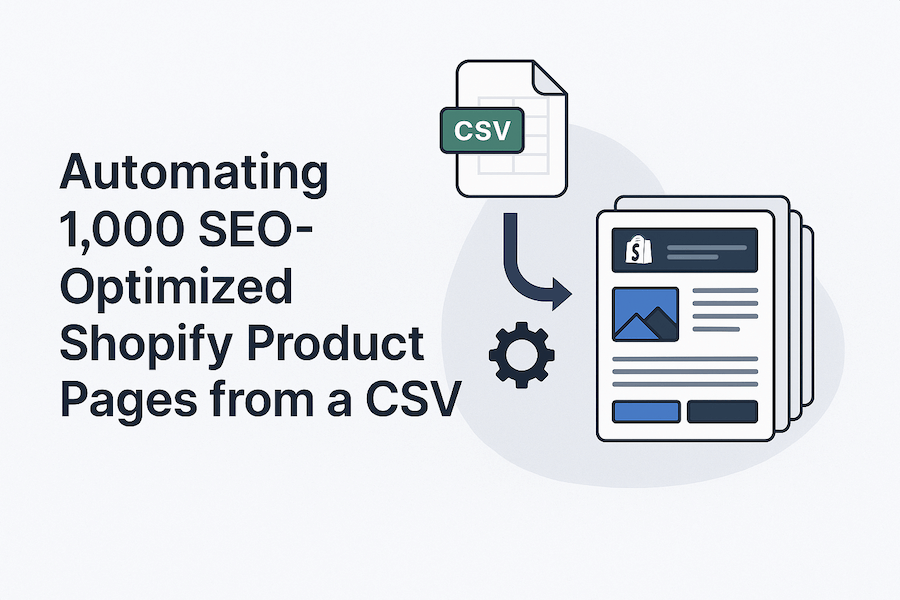Automating 1,000 SEO-Optimized Shopify Product Pages from a CSV

Overview
An eCommerce business had a spreadsheet containing detailed profiles of 1,000 companies. Each row included structured data such as company name, SKU, industry, pricing, tags, and SEO-related metadata. This content had the potential to generate hundreds of high-intent landing pages for organic traffic.
The challenge was scale — turning a CSV into live, optimized product pages without requiring a content or engineering team to manually handle the process.
This case study details how I designed and implemented an automated pipeline to ingest the CSV and generate 1,000 fully optimized Shopify product pages programmatically.
The Challenge
Manually converting CSV rows into Shopify products at this scale would have introduced several issues:
- High labor cost and risk of manual errors
- Risk of duplicate product creation without a proper deduplication mechanism
- Shopify API rate limits, which could interrupt bulk uploads
- SEO inconsistencies due to missed metadata, broken alt tags, or unstructured product content
- The need to map each product to metaobjects and collections for better organization and filtering
The eCommerce team needed a solution that would be hands-off, repeatable, and resilient — one that would allow them to generate SEO-ready content from structured data without writing a line of code or uploading products manually.
Solution Design
I built a backend automation system that:
- Listens for new metaobject creation events via a Shopify webhook.
- Retrieves the uploaded CSV file from Shopify's file storage.
- Parses the file into structured company data.
- Searches Shopify for existing metaobjects using SKU as a unique identifier.
- For each row:
- If the company exists: updates it only if changes are detected.
- If not: creates a new metaobject and associated product.
- Creates a product that:
- References the company metaobject
- Includes pricing, inventory, tags, and SEO metadata
- Uploads an image with custom alt text
- Assigns the product to predefined collections
- Publishes to all sales channels
This system was built to run continuously and scale based on the size of the CSV, completing large batches within minutes while preserving data integrity.
Technical Highlights
- Deduplication: Normalized SKU matching avoids duplicate products and ensures updates are idempotent.
- Rate Limit Protection: Dynamic throttling and batching logic keep the app under Shopify's Admin API rate limits.
- Partial Updates: Only fields that changed in the CSV are updated in Shopify, reducing API calls.
- Metaobject Integration: Each product is linked to a rich
companiesmetaobject for structured internal references. - SEO Optimization: Title, meta description, image alt text, and tags are automatically derived and populated.
- Keep-Alive Logic: Long-running jobs are prevented from suspension using periodic logging.
- Monitoring and Logging: All steps are logged in detail for auditing and debugging purposes.
Tech Stack
| Component | Purpose |
|---|---|
| Node.js (Express) | Backend framework |
| Fly.io | Hosting with autoscaling and health checks |
| Shopify GraphQL Admin API | Shopify integration |
| Shopify metaobject webhooks | Webhook processing |
| CSV ingestion with UTF-8 validation | Data format handling |
| Docker, Fly.io CLI | Deployment tools |
| HTTPS endpoints, environment variables, webhook verification | Security measures |
Results
- 1,000 fully optimized Shopify products generated from a single CSV
- Average processing time: 20 minutes for 500+ rows
- No duplicate records created
- All products linked to metaobjects and published to live sales channels
- Accurate tagging, SEO metadata, and image handling included
- Zero manual data entry required by the client
Why It Matters to eCommerce Managers
This project demonstrates that:
- Existing business data (like a CSV) can be leveraged for meaningful SEO content at scale.
- Automation reduces marketing team dependency on engineering or manual uploads.
- Proper tooling turns structured content into indexable, revenue-generating landing pages.
- SEO and product data consistency can be achieved even at high volume.
- With the right system in place, product content becomes scalable, reliable, and performance-driven.
For eCommerce managers, this approach offers a roadmap for scaling content-led acquisition without growing headcount or complexity. It's a repeatable model for brands with structured product, supplier, or category data — and a need for visibility.